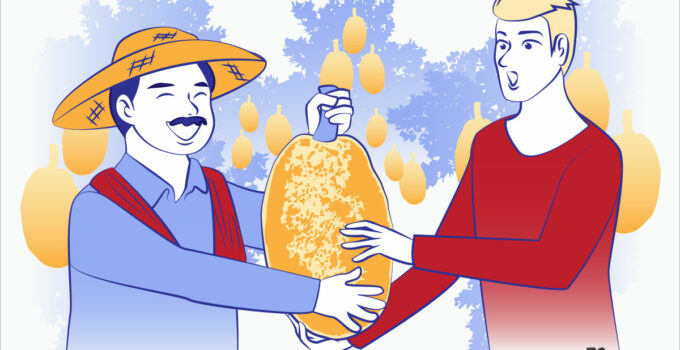Do you like tropical plants and flowers? If you do, Thailand might have blossoms that impress you with their colors, shapes, fragrance, and symbolism. And you might want to find out the most popular plants and flowers in Thailand now.
Thailand’s most significant plants and flowers are the Golden Shower and Lotus. The former is the national tree and flower. Locals believe that planting one on their property boosts their fame and glory. The latter is the symbol of Buddhism. Thais use it to perform religious ceremonies and rituals.
Besides Golden Shower and Lotus, you can find many more exotic trees and blossoms in this country. Read on to discover the most popular Thai flowers and plants and their cultural significance.
What kind of flowers are in Thailand?
1. Lotus Flower or Dok Bua (ดอกบัว)
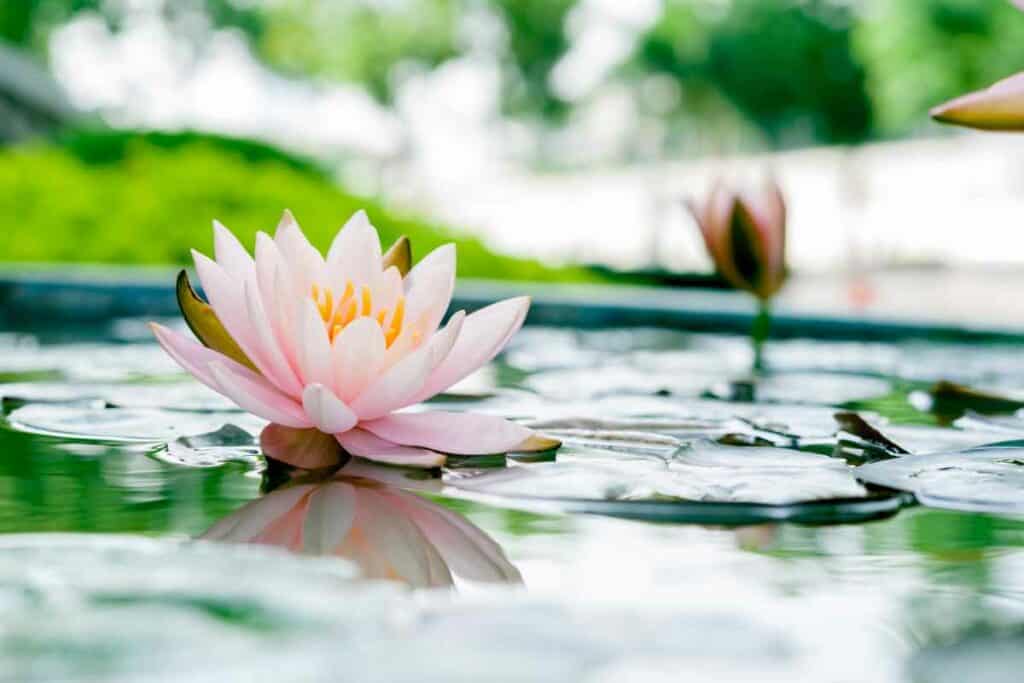
The lotus flower is heavily associated with Buddhism. And since Thailand is a Buddhist country, you can see this flower everywhere.
The legends say that when Buddha was born, he walked seven steps. And under each step, a lotus flower bloomed — protecting the baby’s feet.
Moreover, Buddha compared humans with lotus flowers at the beginning of his preaching journey.
Lotus is a water plant. It grows underground, slowly rises through the water, and blooms above the surface.
Buddha said some people are like the underground lotuses — still new to the teaching and will take a long time to reach enlightenment. Some people are like underwater lotuses — well-equipped with knowledge but not enough to reach enlightenment. And some people are like blooming lotuses — wise and righteous, ready to reach Nirvana any time.
Today, Thai people use lotus flowers to pay respect to monks and Buddha’s image.
Aside from its religious aspect, Lotus is also edible. You can eat its seeds, trunks, and even roots. Seeds and roots are dessert ingredients, while the trunks go into curries.
▸ READ MORE about the Lotus flower in Thailand here.
2. Jasmine or Mali (มะลิ)
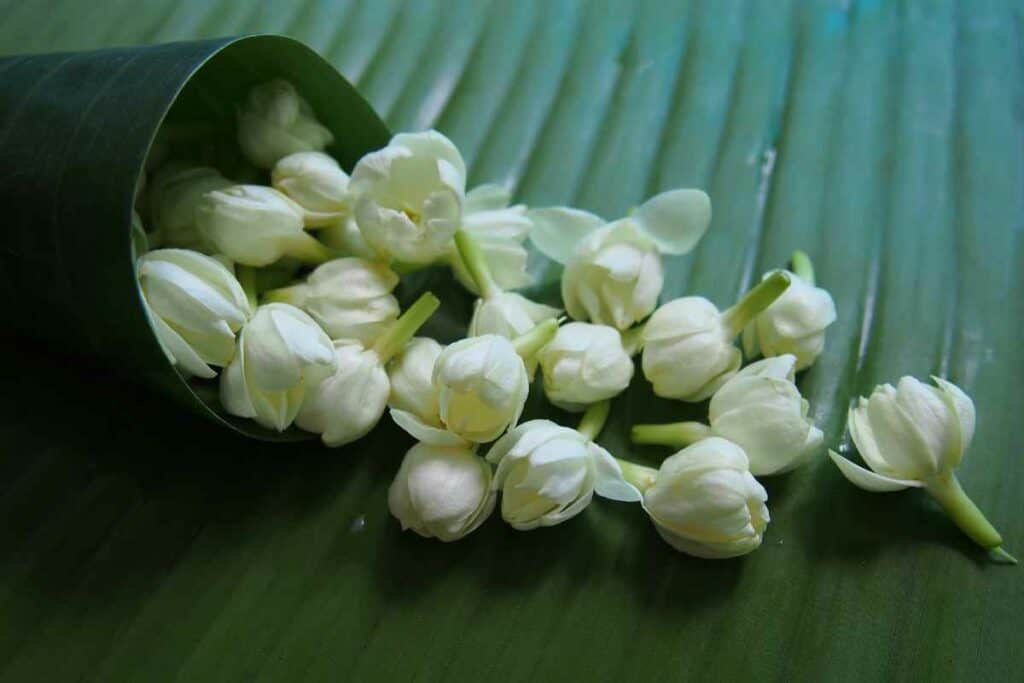
Many countries use carnations as Mother’s Day flowers, but Thailand uses Jasmine. Why? Because in Thai culture, the white Jasmine represents purity and love.
Locals believe that a mother’s love for her children is the purest in the world. So, Jasmine is a perfect representation.
However, you can also look at it the other way around. Carnations are rare in Thailand. So, why would Thai people select such a hard-to-find symbol of love when they already have one?
The question of rarity aside, Jasmine also has a role in the religious scene.
Many monks use Jasmine — or its extract — to create holy water. The sacred quality of the flower might be hard to prove with science, but its fragrance is evident. So, the next time you find holy water in Thailand, try giving it a whiff. If it smells great, it could be thanks to Jasmine.
3. Orchid or Kluai Mai (กล้วยไม้)
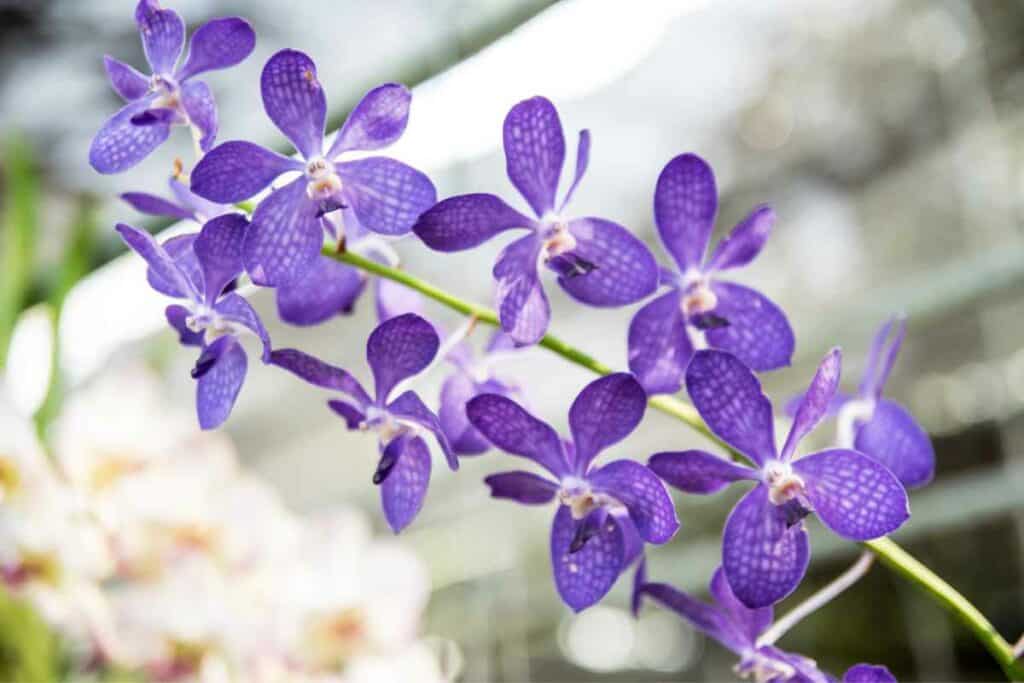
Whenever you look up the world’s most beautiful flowers, orchids are always on the list. And you can find many of them in Thailand.
Most Thais grow this exotic flower for its beauty. The most common species in Thailand is the white and purple. You can find some yellow ones, but they are not as abundant.
Even though Orchids symbolize wealth and love, not many Thais care about that. But in the early 2000s, most Thai knew that Orchids were pricey.
It was considered a rare plant and a valuable economic flower. Since Orchids took a long time and arduous effort to grow, the market in Thailand saw high demand and spiked its price.
However, technology has made everything easy. And in the 2020s, Orchid is not as expensive as it used to be. But still, it can cost you big bucks to buy a rare one.
4. Bougainvillea or Fueang Fah (เฟื่องฟ้า)
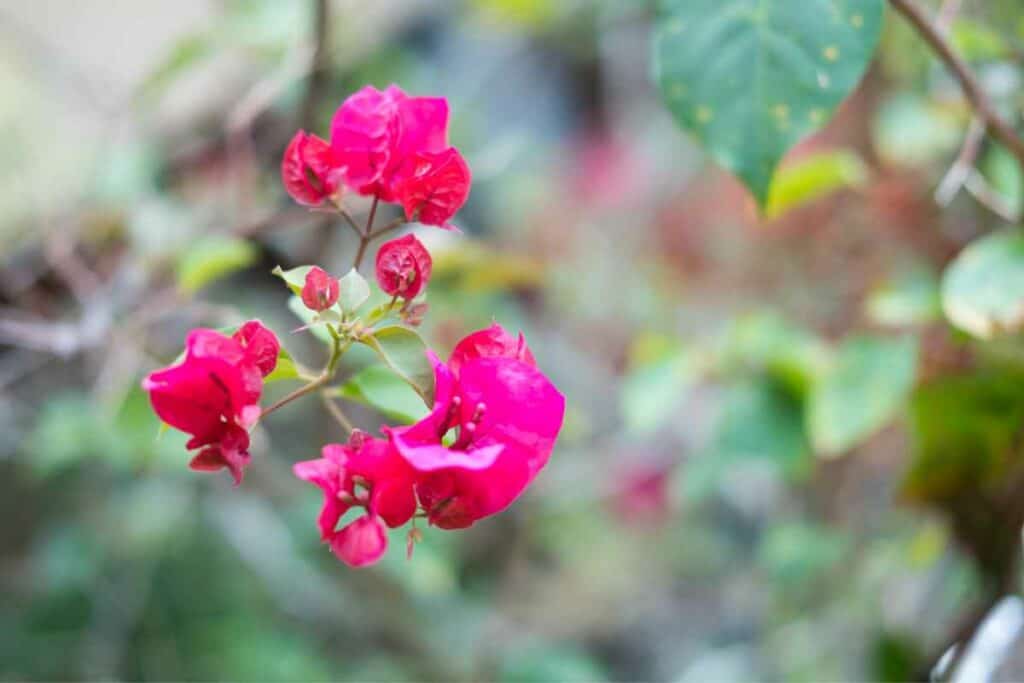
This flower is everywhere in Thailand. You can see it in people’s houses, the temple, the wild, or even traffic islands.
The most notable feature of this flower is its bright pink color. You can’t miss it even with one eye closed when passing by. Of course, there are white species too, but it isn’t as iconic as the pink one.
In terms of meaning, this flower symbolizes growth and fame. In Thai, Bougainvillea is called Fueang Fah. It’s an analogy term that means “your fame reaches the sky.” Basically, extremely famous.
Even though Bougainvillea is quite a fragile flower, its growth speed is nothing to spit at. It might take lots of effort to take care of this tree. But once it starts growing, it gets wider and wider. So, remember that you might have to cut its branch often when you plant this tree.
5. Ixora or Dok Khem (ดอกเข็ม)
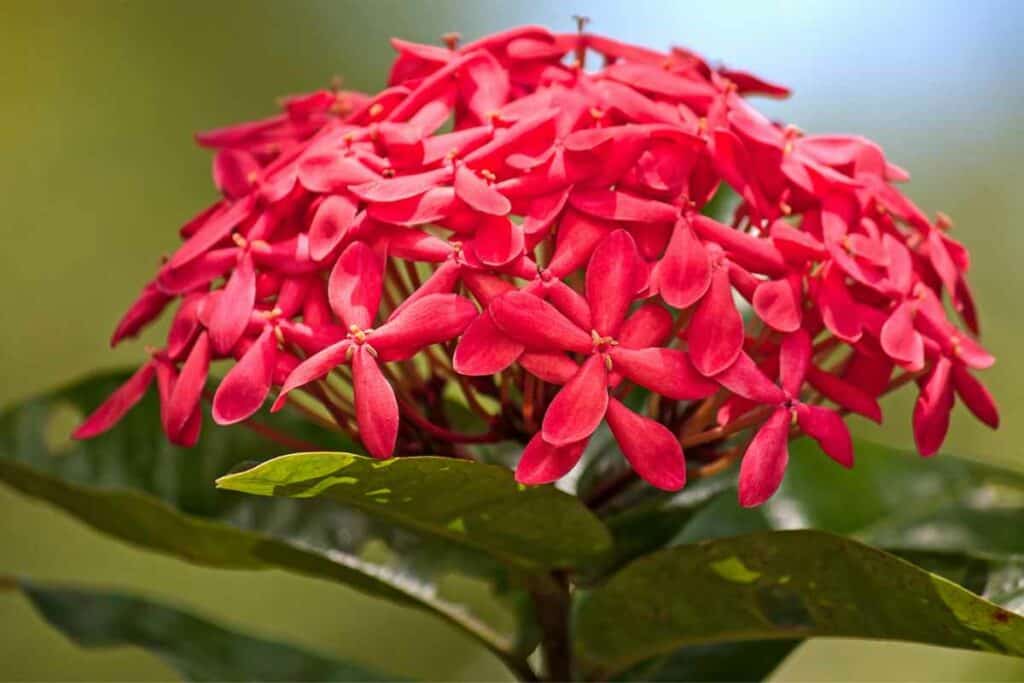
This flower is one of the most iconic flowers during Thai people’s childhood. Why? Because this flower is associated with Teacher’s day.
The pointy, long, and thin characteristics of the flower resemble those of needles. And needles are called “Khem” in Thai. Hence the name Dok Khem — a symbol of intelligence and wisdom.
When Thai people want to compliment someone as intelligent or sharp, they will say, “your intellect is pointy.” So, Ixora or Dok Khem possesses such a “pointy” quality. That’s why it’s used on Teacher’s day to represent the teacher’s wisdom.
What plants are popular in Thailand?
There are more than thousands of plant species native to Thailand. However, not all of them are equal in reputation and fame.
Some trees are widely planted in the house because of their colors, shapes, fragrance, and fruit. Others are grown for their meanings and symbolism. And here are the top 5 plants you can find in Thailand.
1. Golden Shower or Ratchaphruek (ราชพฤกษ์)
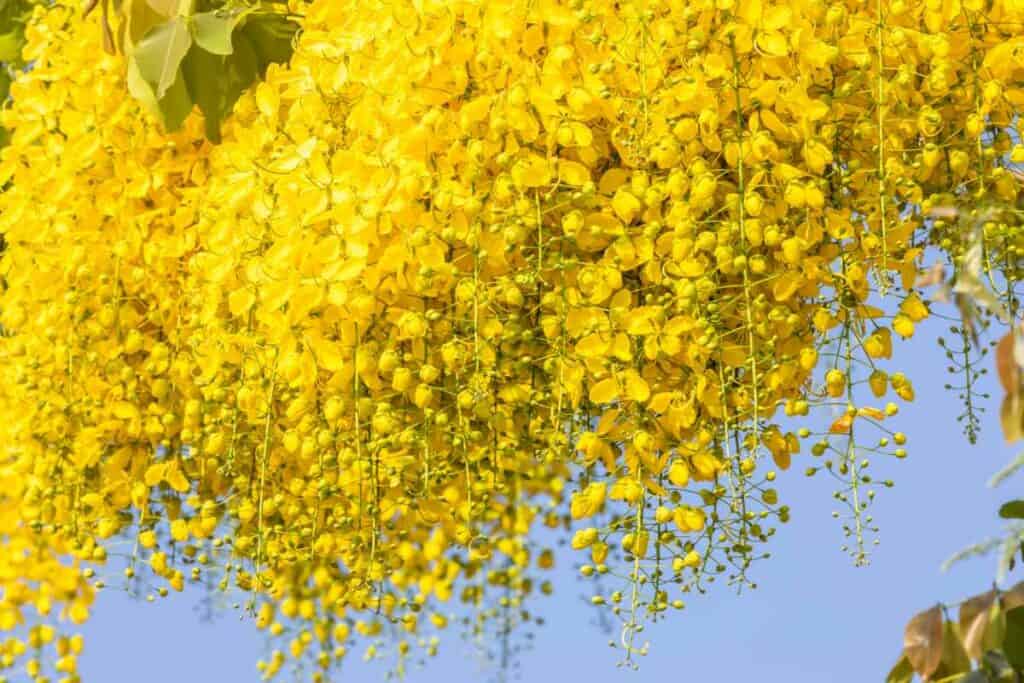
As mentioned, this tree with yellow flowers is the Thai national tree.
The reasons it was chosen as the national tree are simple. It’s gorgeous, symbolizes positive ideas, and its functionality is numerous.
The beauty of this tree needs no explanation. It looks fabulous in your garden and in the wild. Most people fall in love with its bright yellow color and curtain-like appearance. Rows of this tree in a backyard is an Instagram-worthy view.
Golden Shower is also a Thai “lucky” tree. It is a symbol of fame, glory, and unity. So, many locals plant it on their property — believing that the tree will boost their reputation.
On the medical side, Golden Shower also shines with various medicinal effects. You can use its pods as antimalarial drugs. Its seeds are laxative and antiemetic, and its roots can cure an infection, etc.
Finally, Golden Shower boasts high durability and longevity. You can cut it down as wood for constructing houses and other structures.
With all these functions and qualities, it is no surprise that Thai people love this tree. And you might be too.
2. Bodhi (โพธิ์)
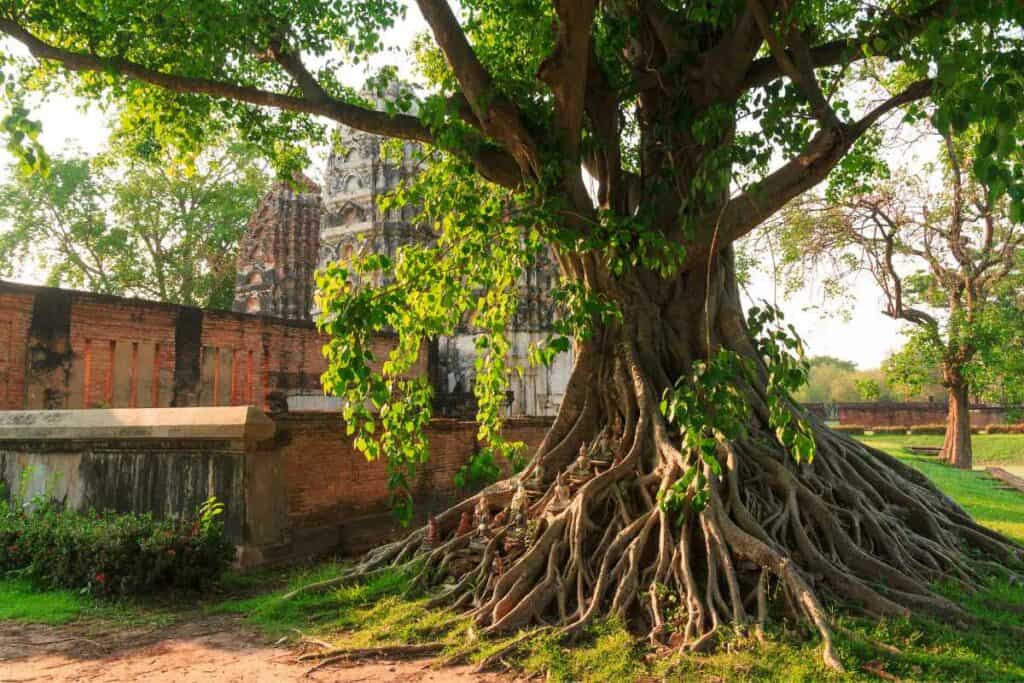
As you know, Buddhism influences numerous aspects of Thai culture. So, it’s no surprise that one of the most significant plants in Buddhist lore, like the Bodhi tree, is popular in Thailand.
The Bodhi tree is heavily associated with the Buddha himself. According to the legends, Buddha reached enlightenment while meditating under this tree.
You can see Bodhi trees in almost every temple in Thailand. And most of them are wrapped with colorful pieces of cloth the locals put up to highlight the tree’s sacredness.
Another notable feature of Bodhi is its leaves. They have a shape similar to a heart. Even though this doesn’t symbolize anything in Thai culture, it’s still a feature unique to this tree.
For its functionality, Bodhi doesn’t provide much. Despite its massive size and wood volume, Thai people don’t cut Bodhi trees to make houses. The tree is considered too sacred to cut or use for anything.
3. Durian (ทุเรียน)
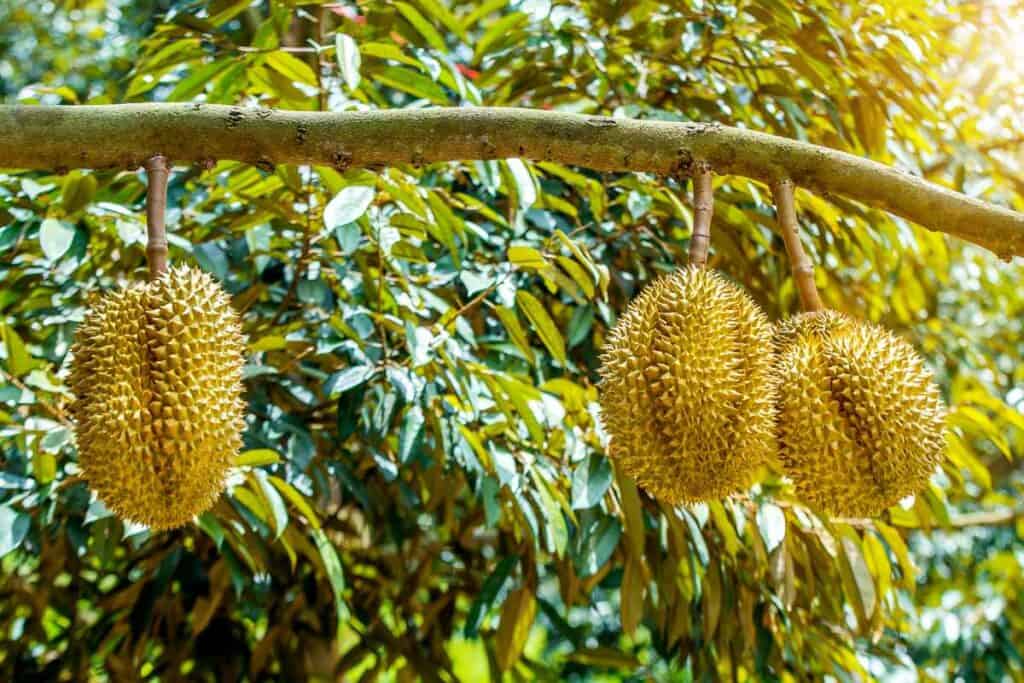
For those who don’t know, Durians are the king of fruit. The reason for that is unclear. But what’s clear about it is this fruit will hurt you if you don’t handle it carefully.
Durian fruit is covered with a thick thorny shell. This makes harvesting and peeling a painful experience if you’re not a pro. But the golden flesh waiting for you inside might make it worth it.
Even though Durians are called the king of fruit, they’re not always delicious. Why? Because Durians have a unique smell that will appeal to some people but repel others away. You either love it or hate it — no middle ground. Even the locals are divided when it comes to Durians’ edibility.
Despite its controversial flavor, Durians are still on the top list of Thai “lucky” trees. Since they have golden flesh, Thai people believe they invite wealth and prosperity. So, some houses may have a Durian tree even though nobody in the family eats the fruit.
4. Star Gooseberry or Mayom (มะยม)
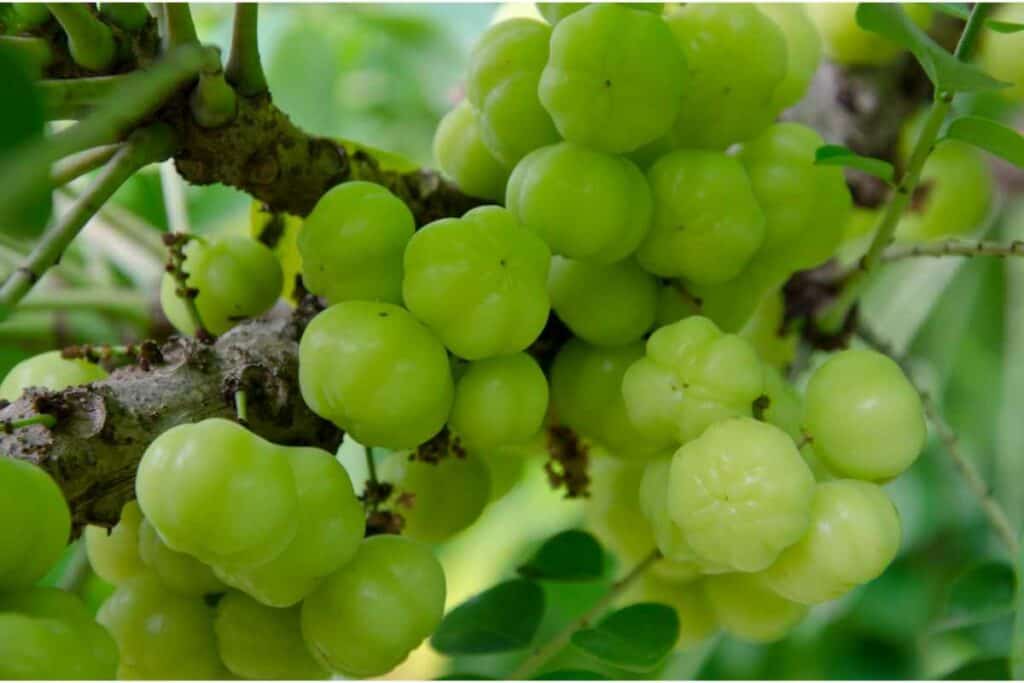
This tree is also one of many “lucky” trees in Thailand.
Locals believe that if you plant this tree in front of your house, the community will love your household. This might sound superstitious (and it is), but it actually has an origin.
In Thai, Star Gooseberry is called “Mayom” (มะยม). This name sounds similar to “Niyom,” which means famous or beloved. So, plant “Mayom” in front of your house, and people will “Niyom” you.
As the name suggests, this tree is a kind of berry. And that means you can eat its fruit. However, the taste of the raw fruit is either too astringent or too sour. So, people sugarcoat it and enjoy it as sweet.
Another (not so) funny thing about Star Gooseberry is its hidden functionality. In the old days, Thai people believed you should discipline your children by spanking. And they don’t spank with bare hands. They use a branch of this tree.
The leafless Star Gooseberry branch is thin and long. So it is a perfect tool to spank someone with. The damage is nothing significant, but it definitely sends the message.
5. Jack Fruit Tree or Kanoon (ขนุน)
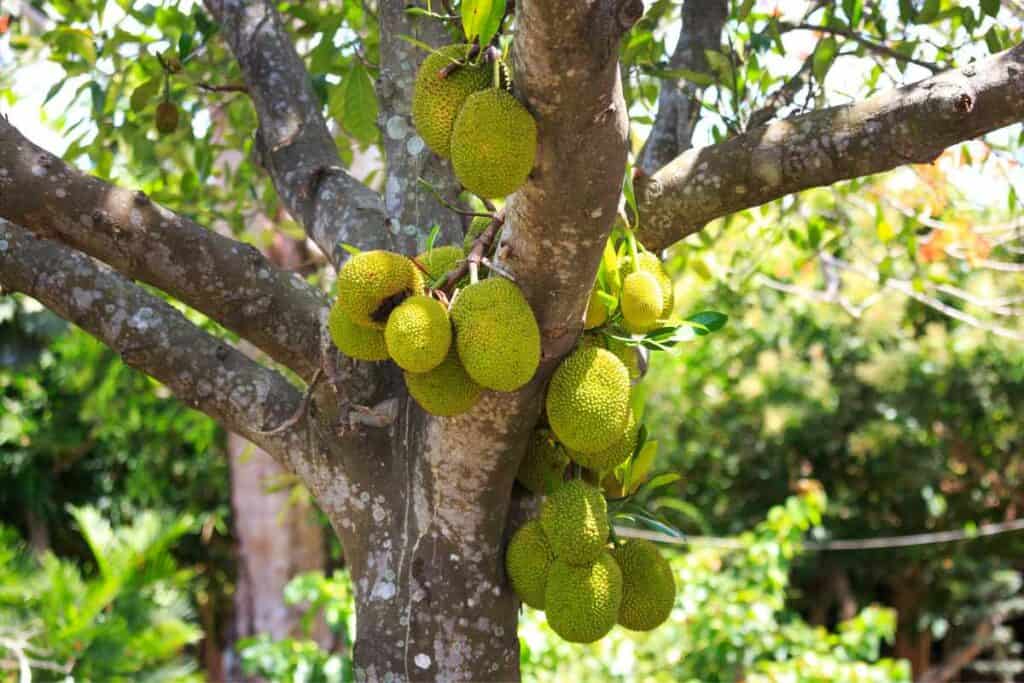
Yet another “lucky” tree of Thailand.
If Star Gooseberry is meant to be planted at the front of your house, Jack Fruit is one for the back. The logic is quite similar. Yes, it’s another pun.
In Thai, Jack Fruit is called “Kanoon.” And as you can see, the name has “noon.” And “noon” (หนุน) means “to support.” So, plant this tree at the back of your house, so someone (or some mysterious power) will “back you up.”
Jack Fruit trees have a similar-looking fruit to Durians. They both have spiky shells. However, Jack Fruit’s thorns are short and not as strong as durian.
For the taste, Jack Fruit is sweet. And most people are okay with eating it since its smell is “normal.” Several Thai desserts even include this fruit to add a different shade of sweetness to the dish.
Thai flowers, Thai values
As you can see, Thailand’s popular plants and flowers also reflect local culture and values.
Some of them might make sense. Some of them might not. But those are what makes Thailand such a fascinating place to visit. Even trees are culturally significant in this country.
So, if you’re a big fan of floral and botanical study, find time to go to Thailand. You will definitely enjoy your time there.
Like always, if you want to discover more about Thailand, stay guided with ThaiGuider. You might learn something you never knew about this unique country.
▸ CHECK OUT all our guides on Thai Culture here.
THINKING ABOUT A TRIP TO THAILAND?
I am working on a FREE Thailand Travel Guide with a FULL 7 Day Itinerary. Be the first to receive it!
Thank you for signing up.
Something went wrong.
